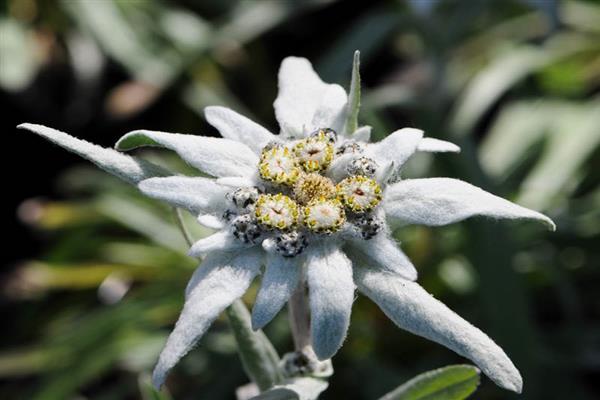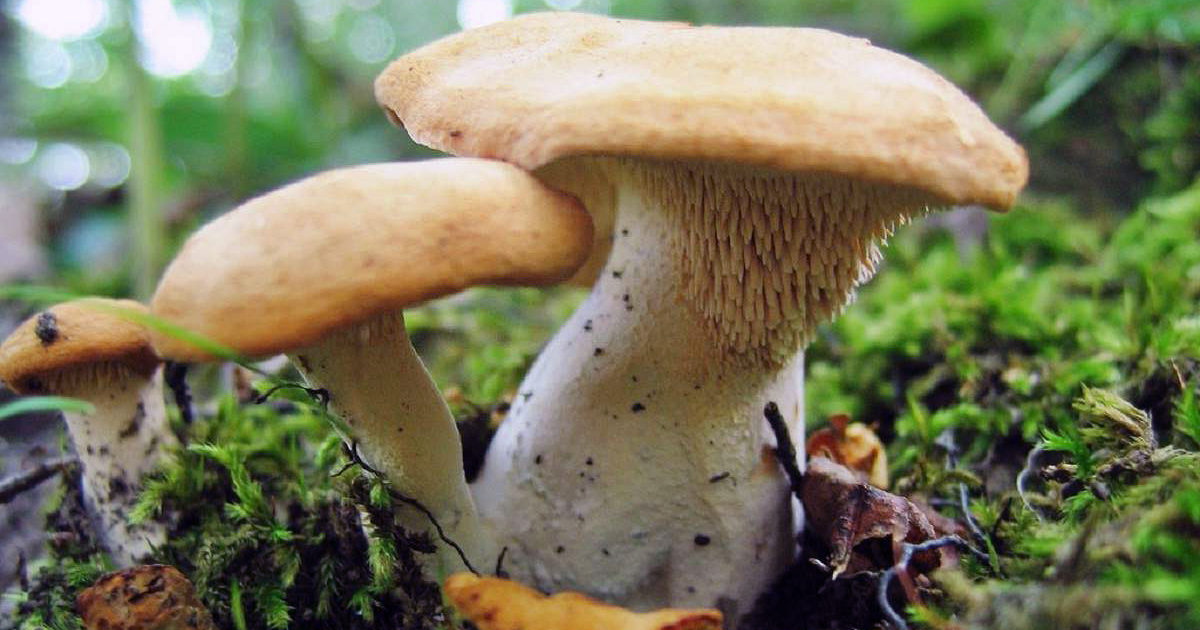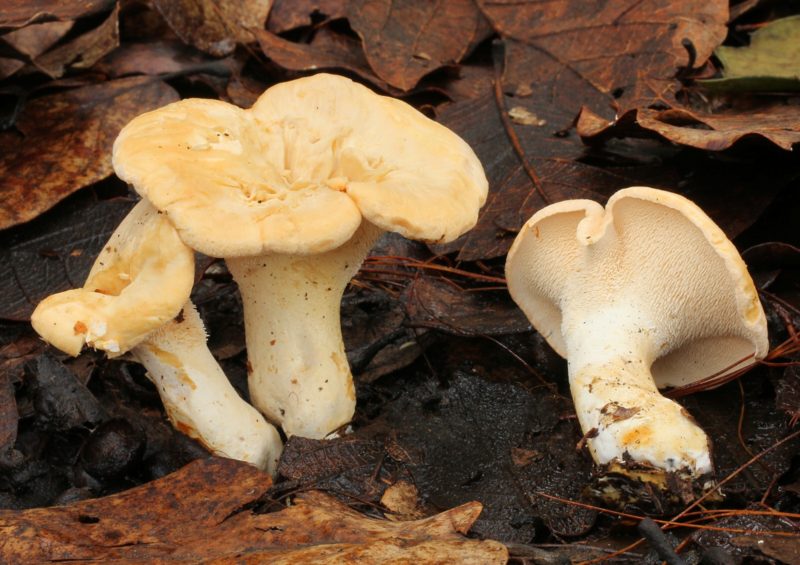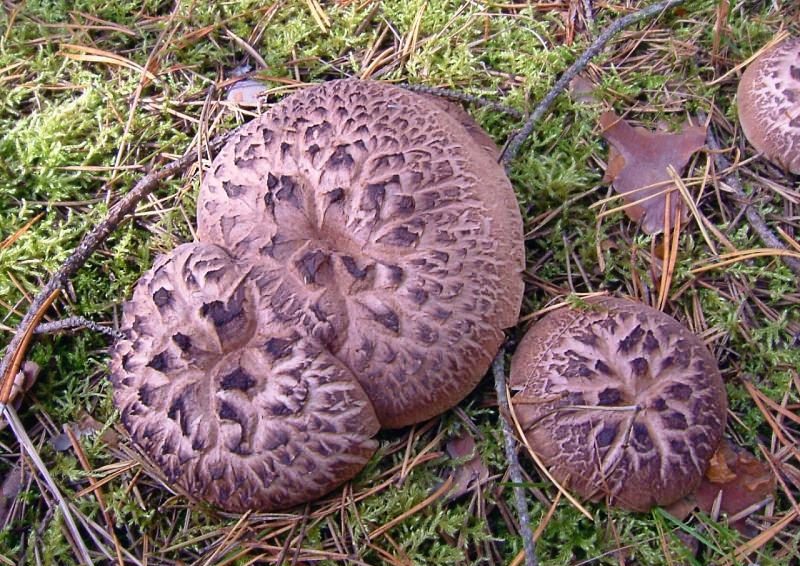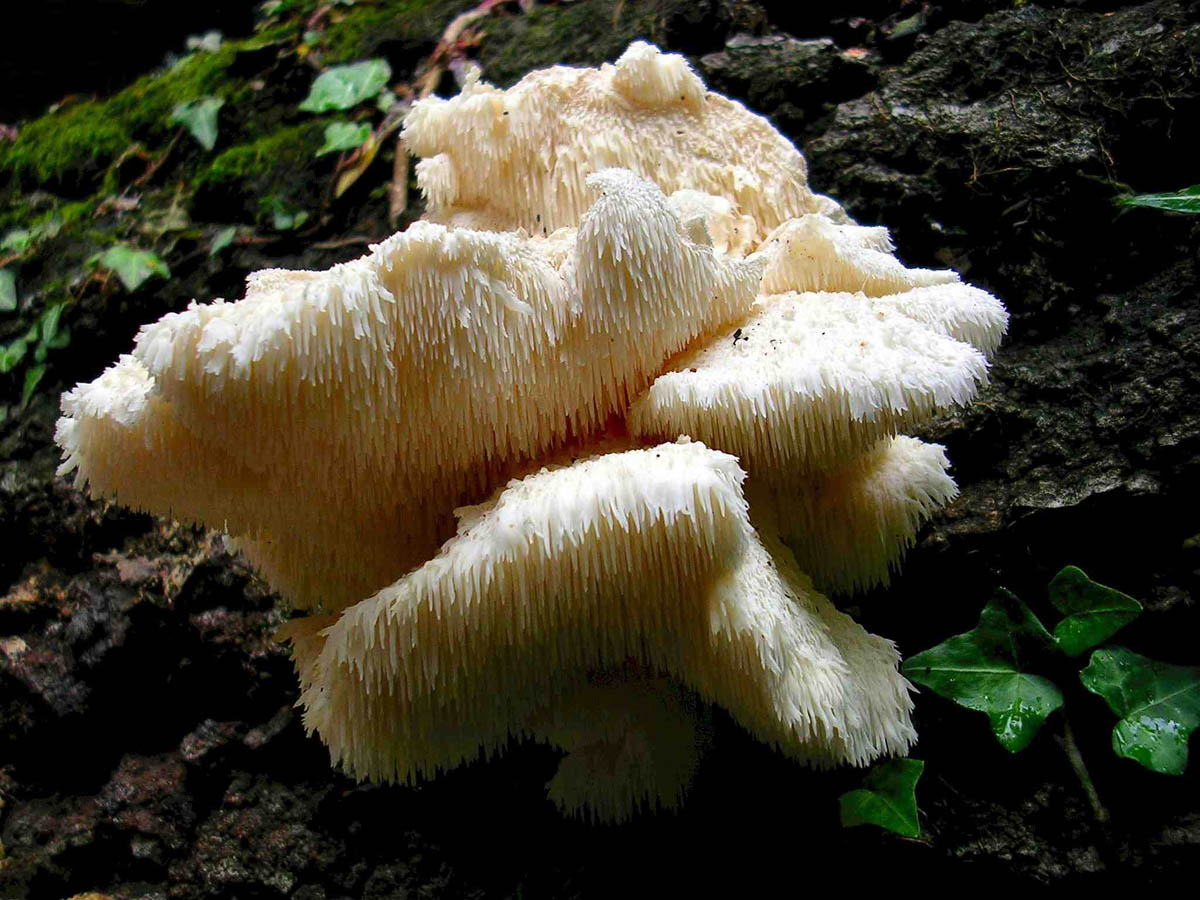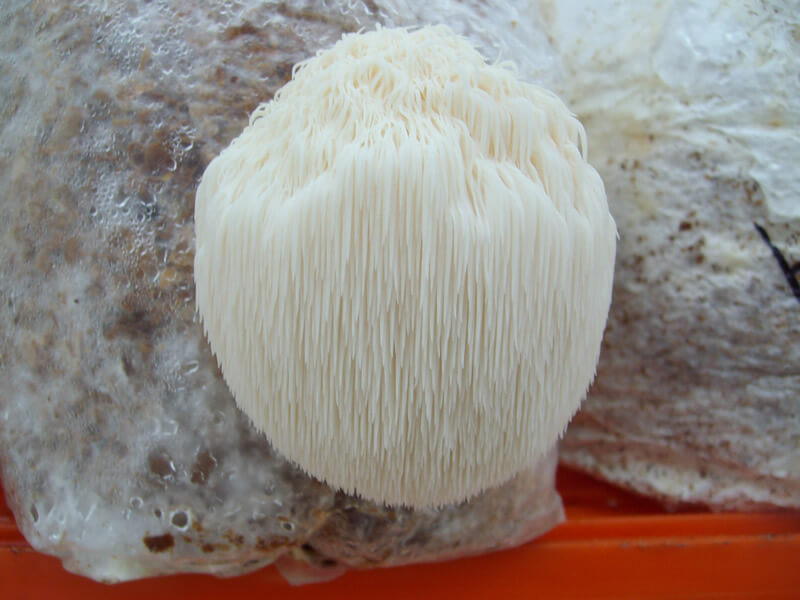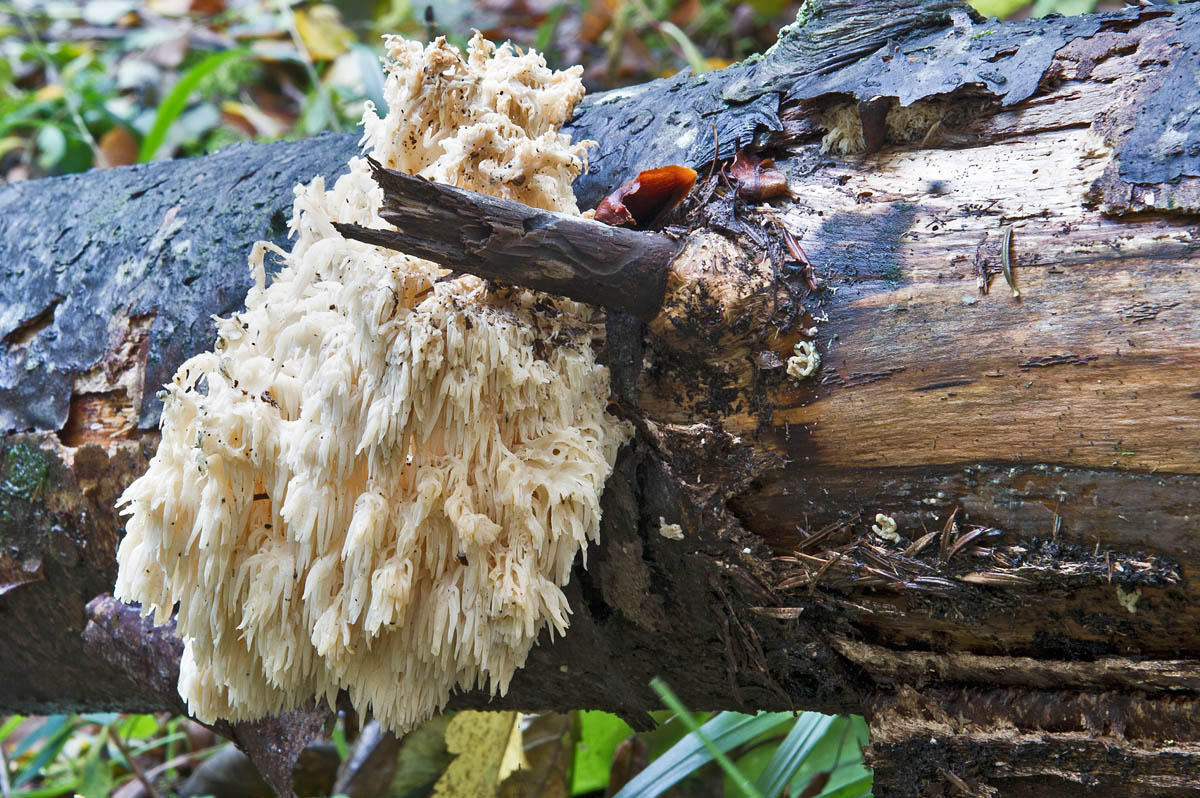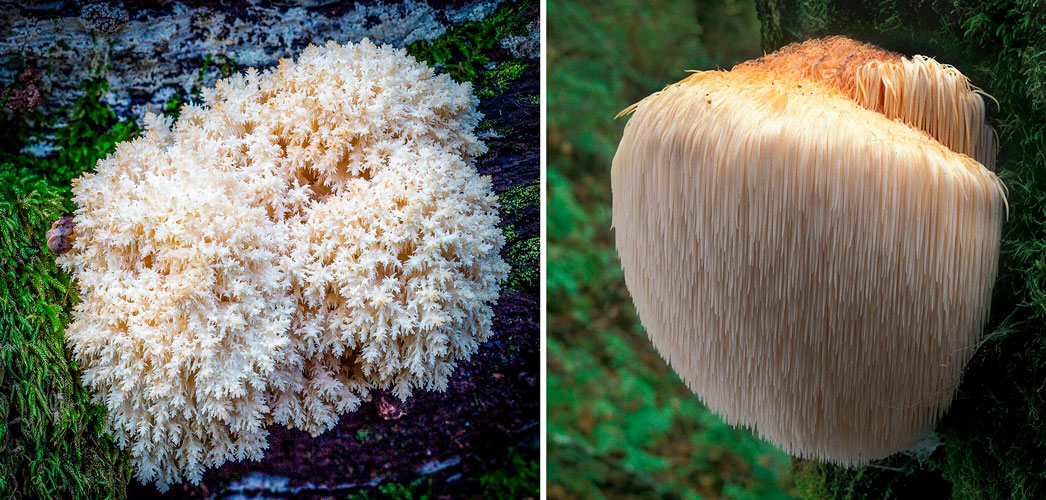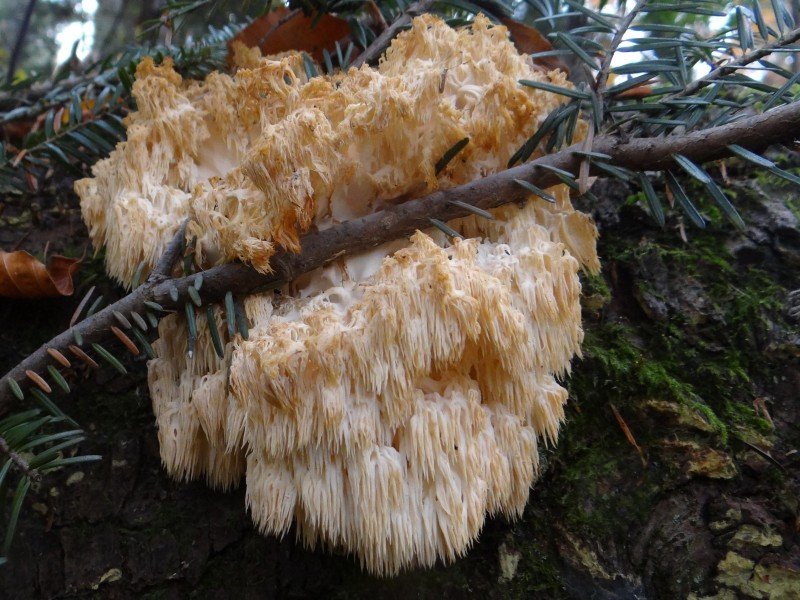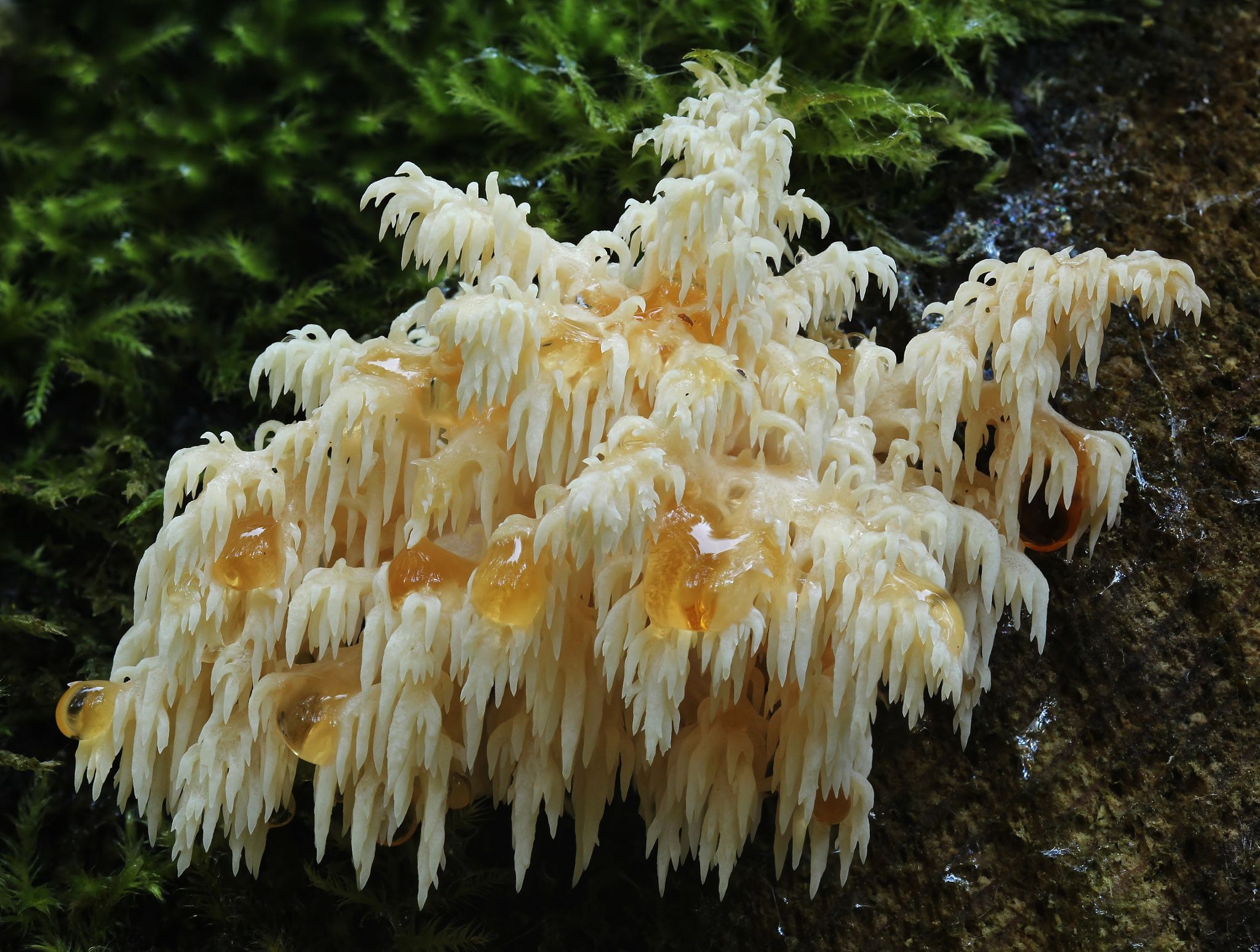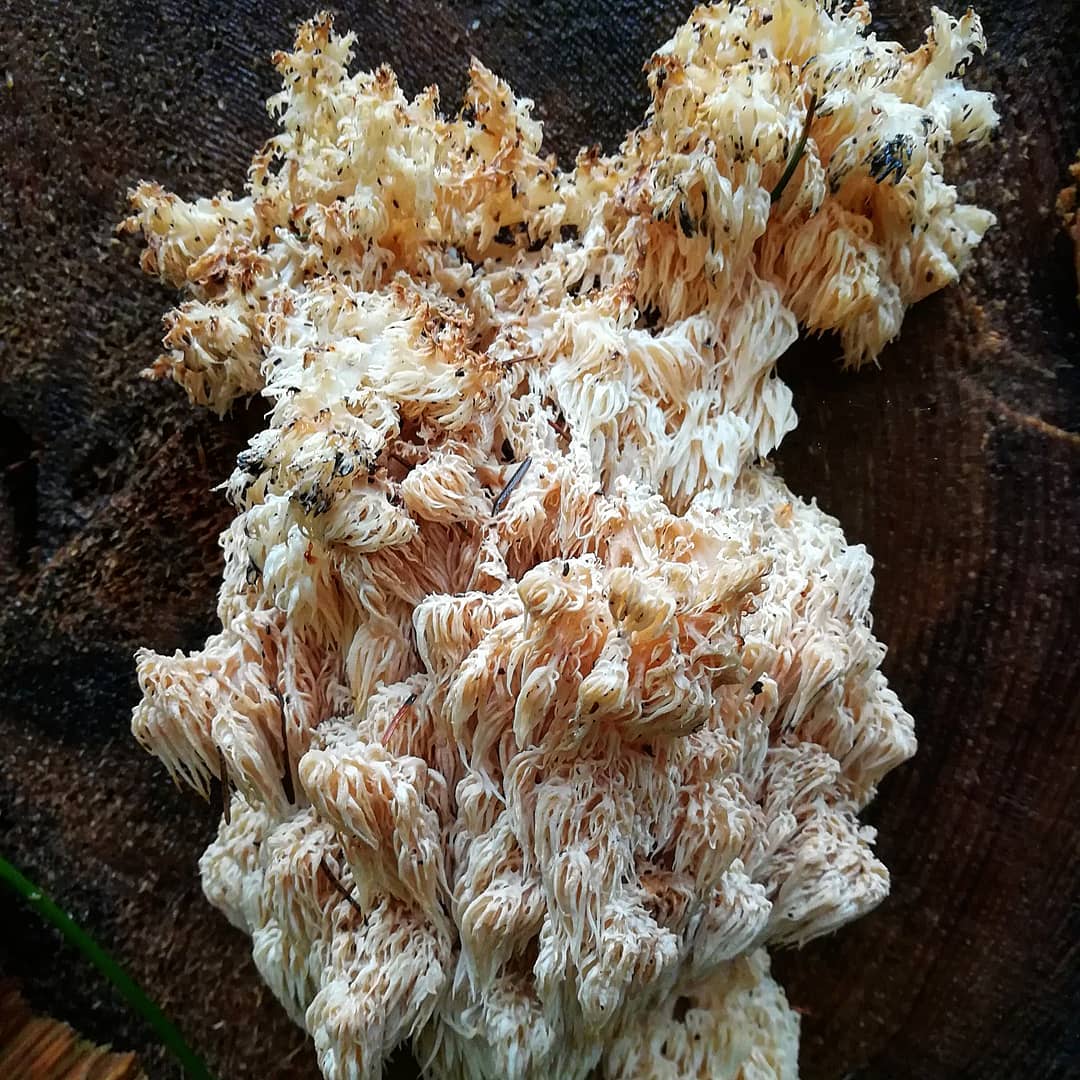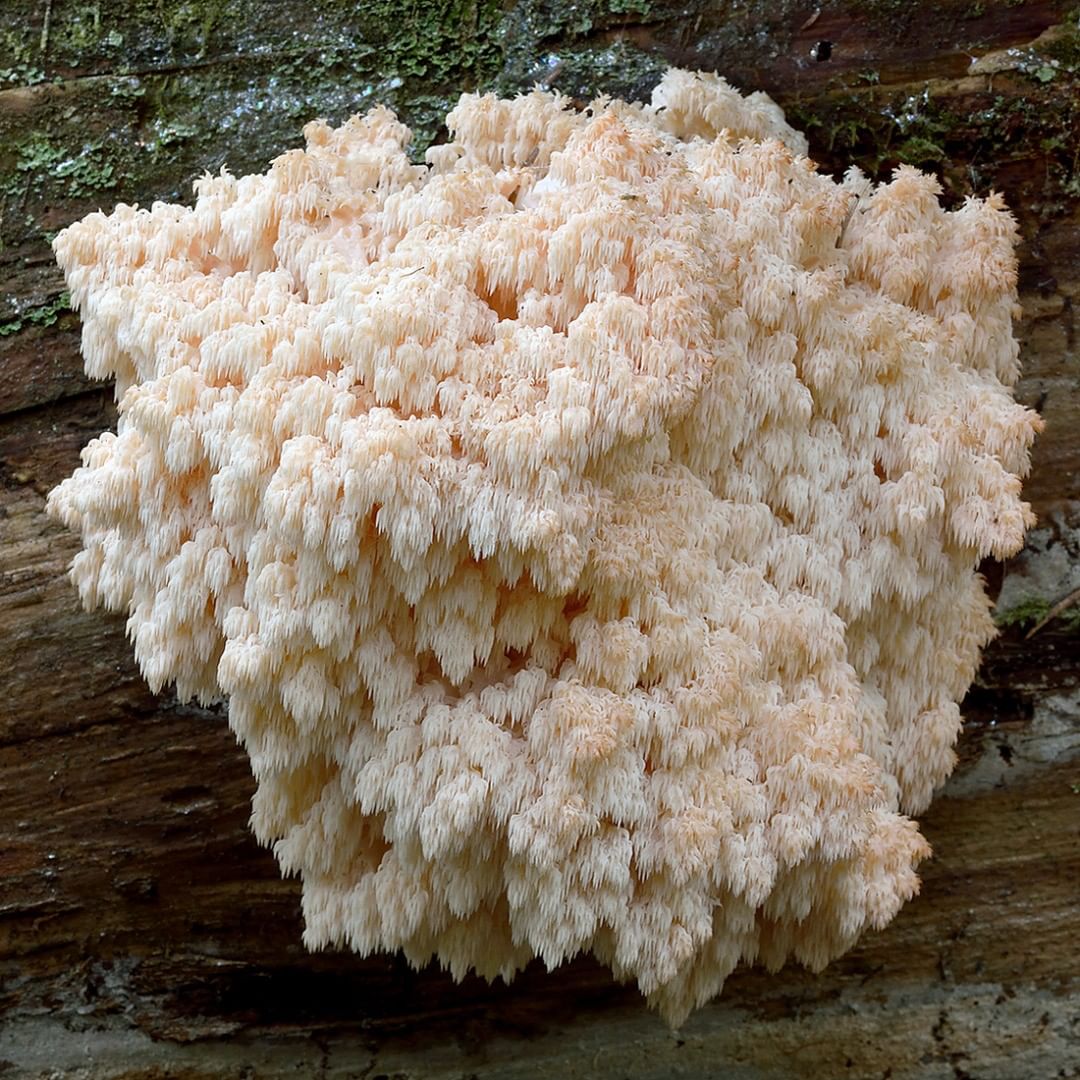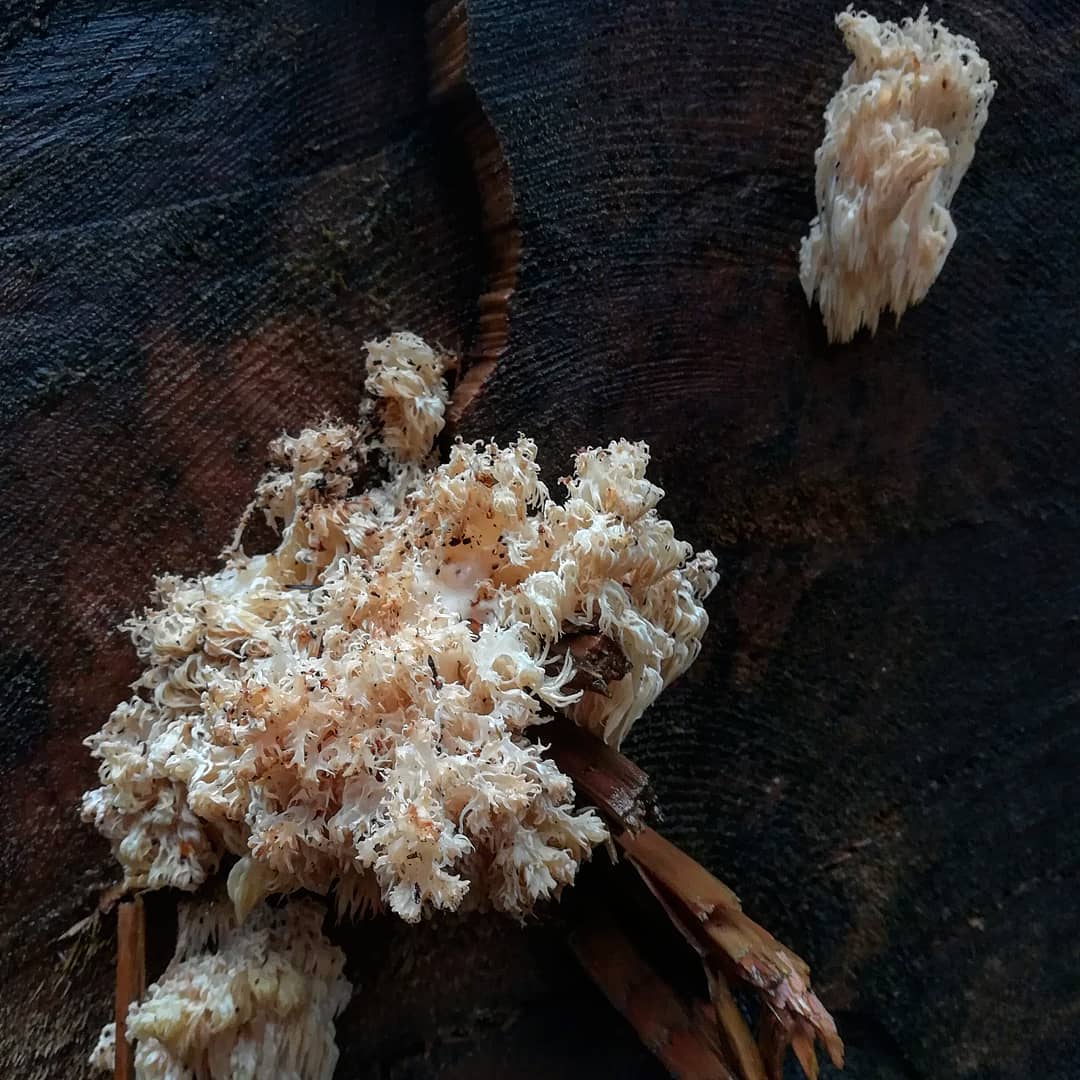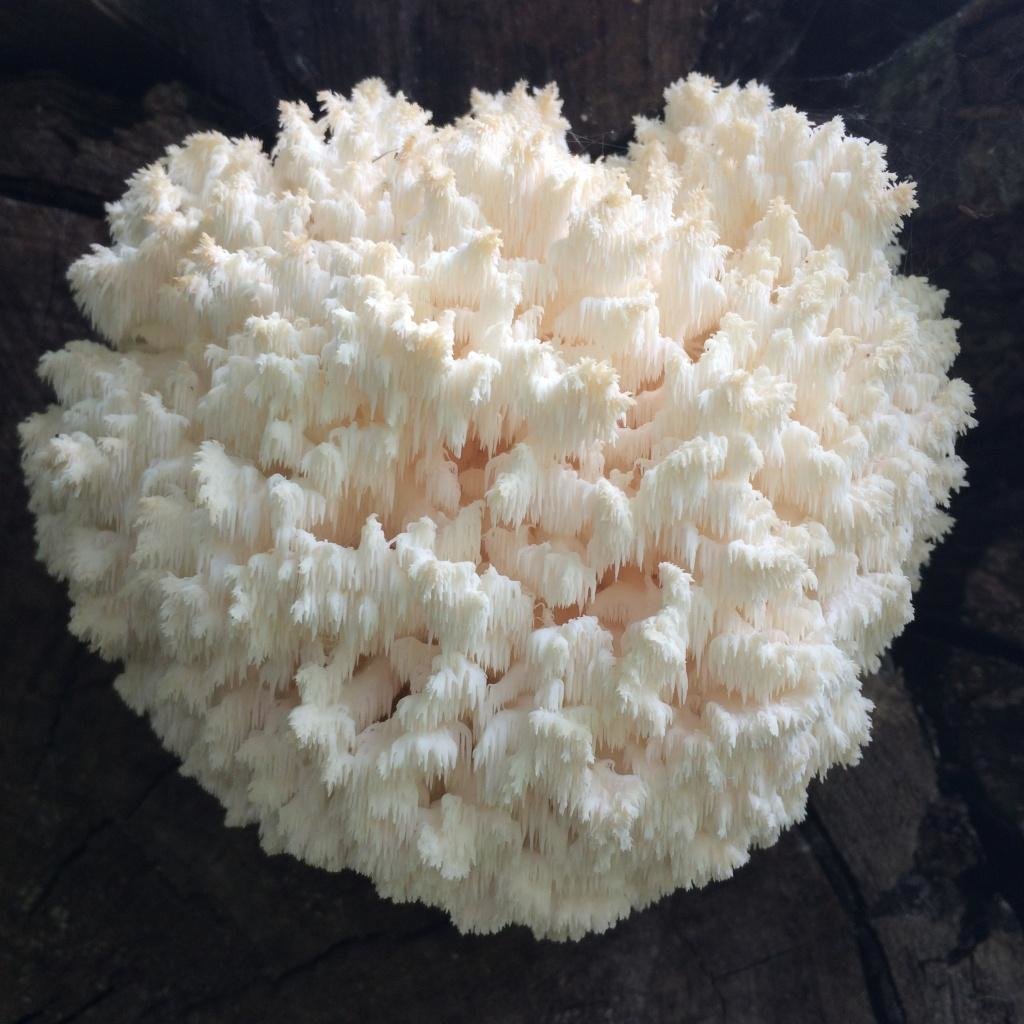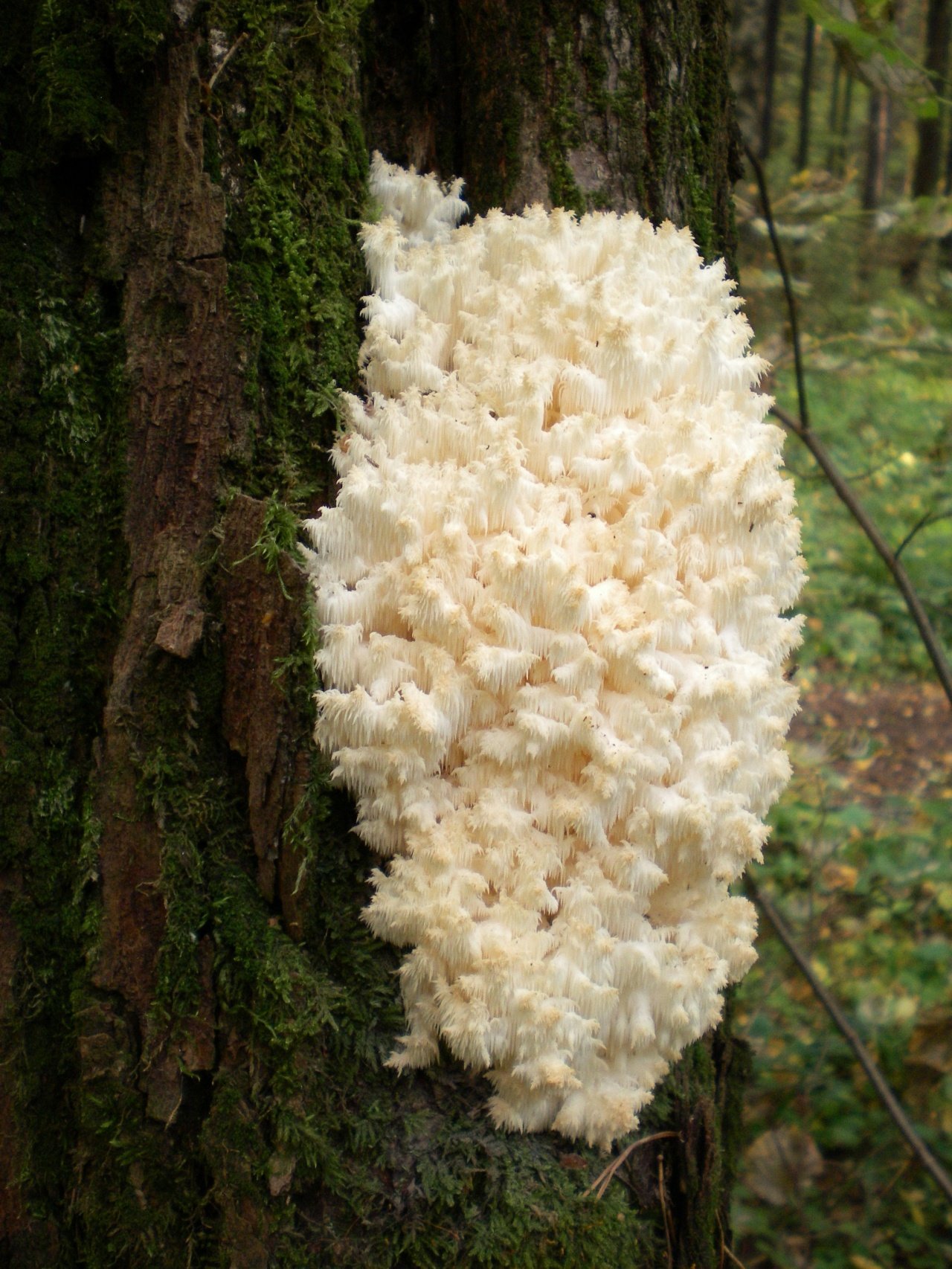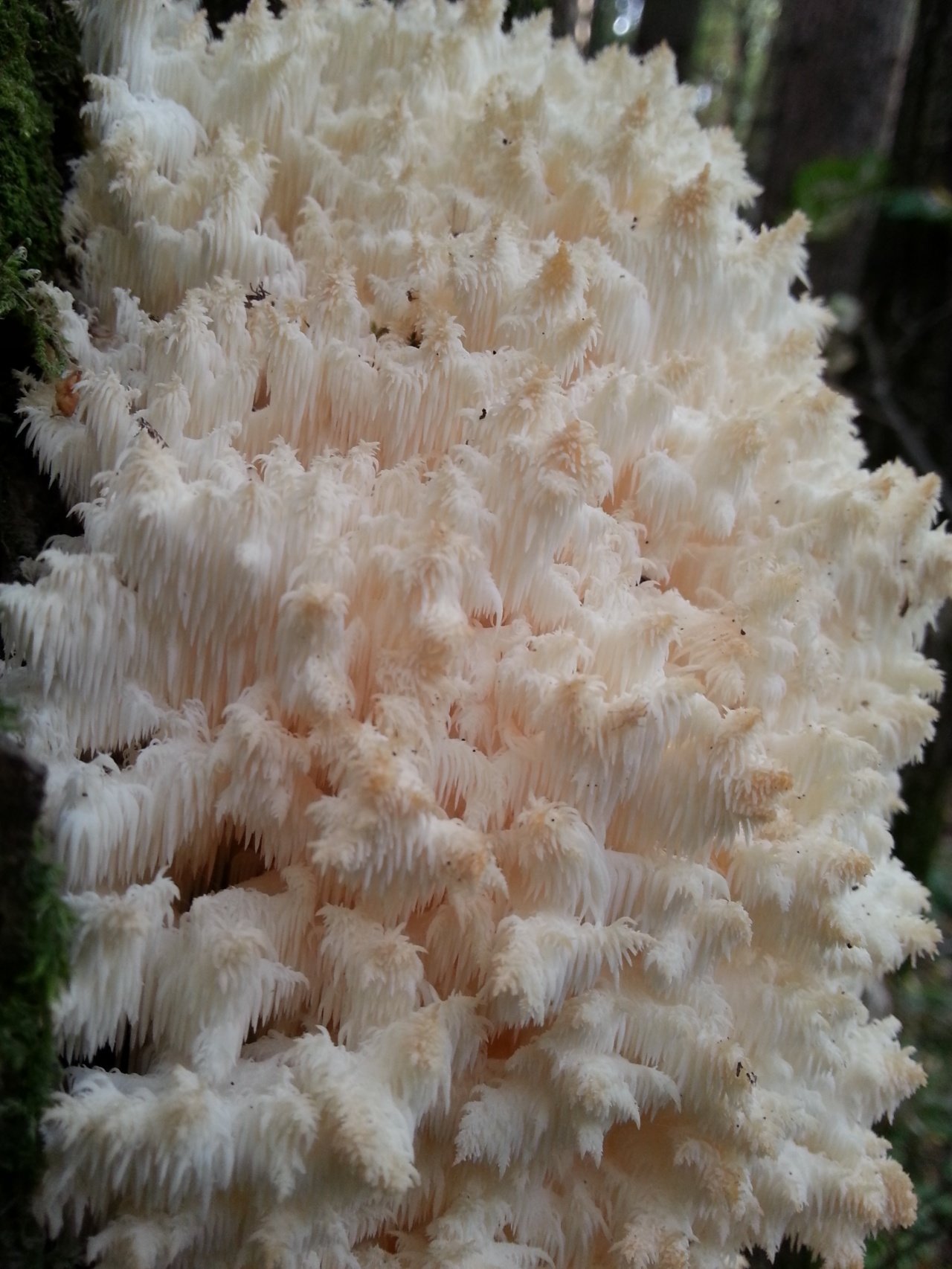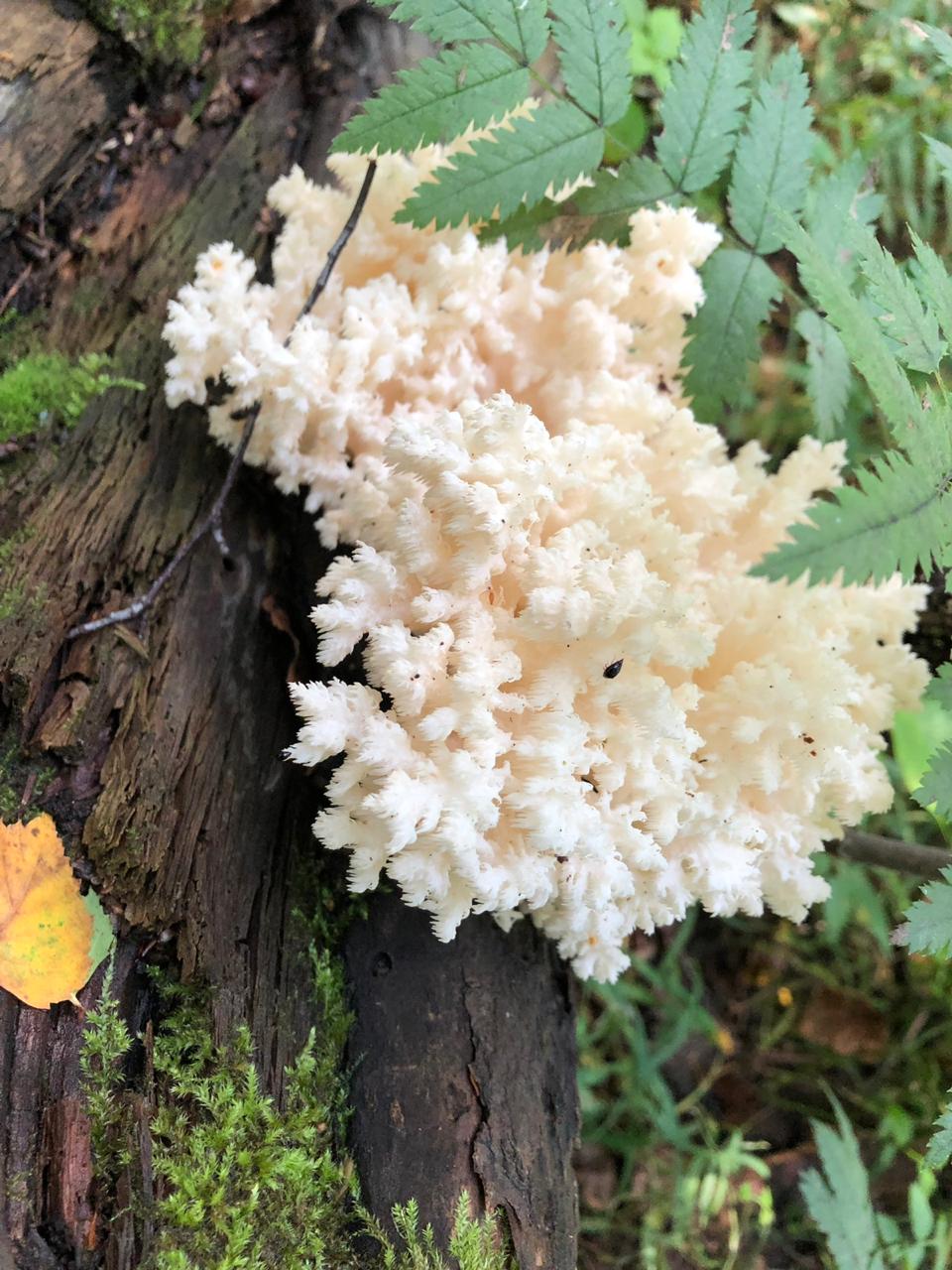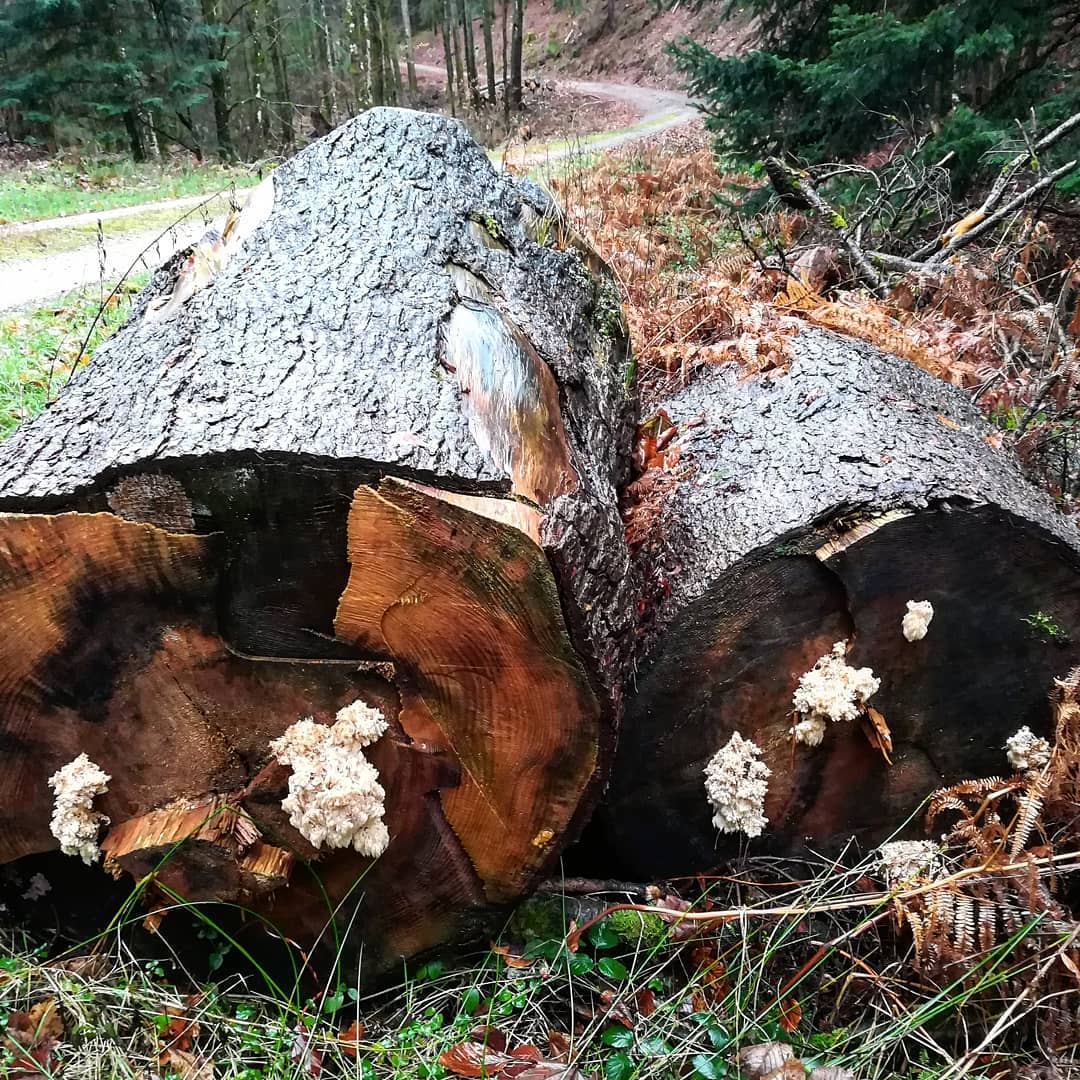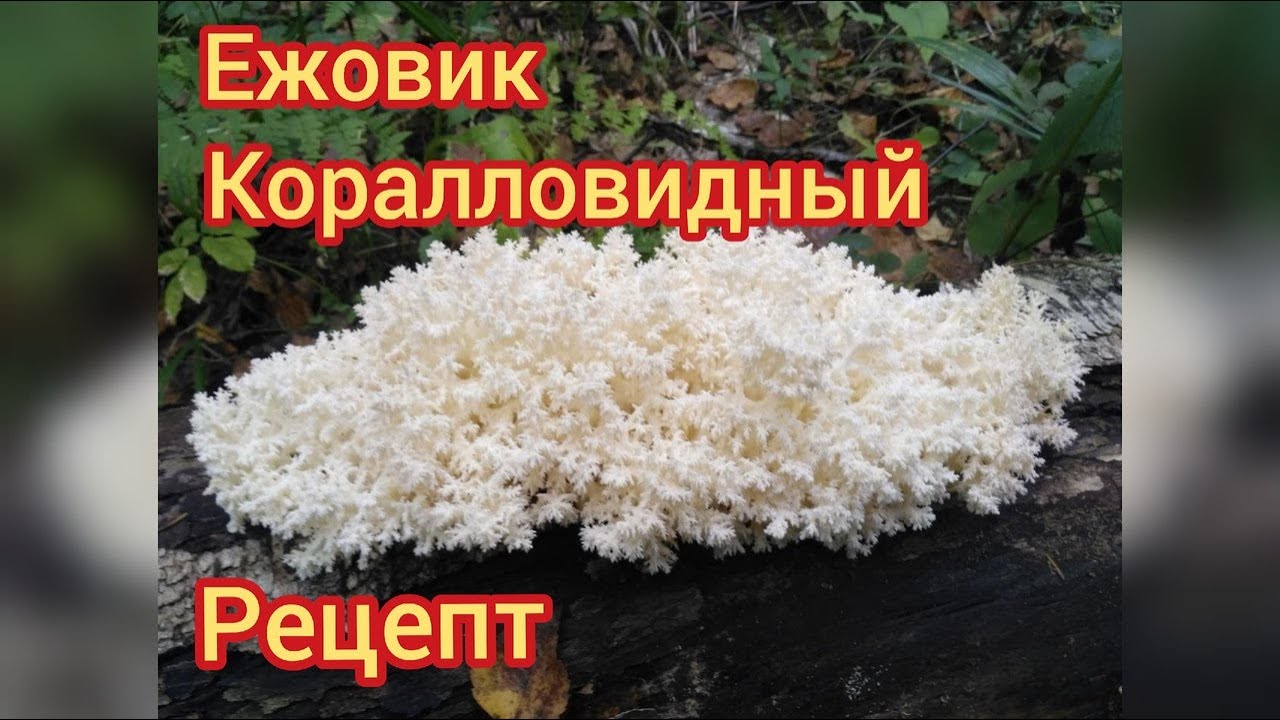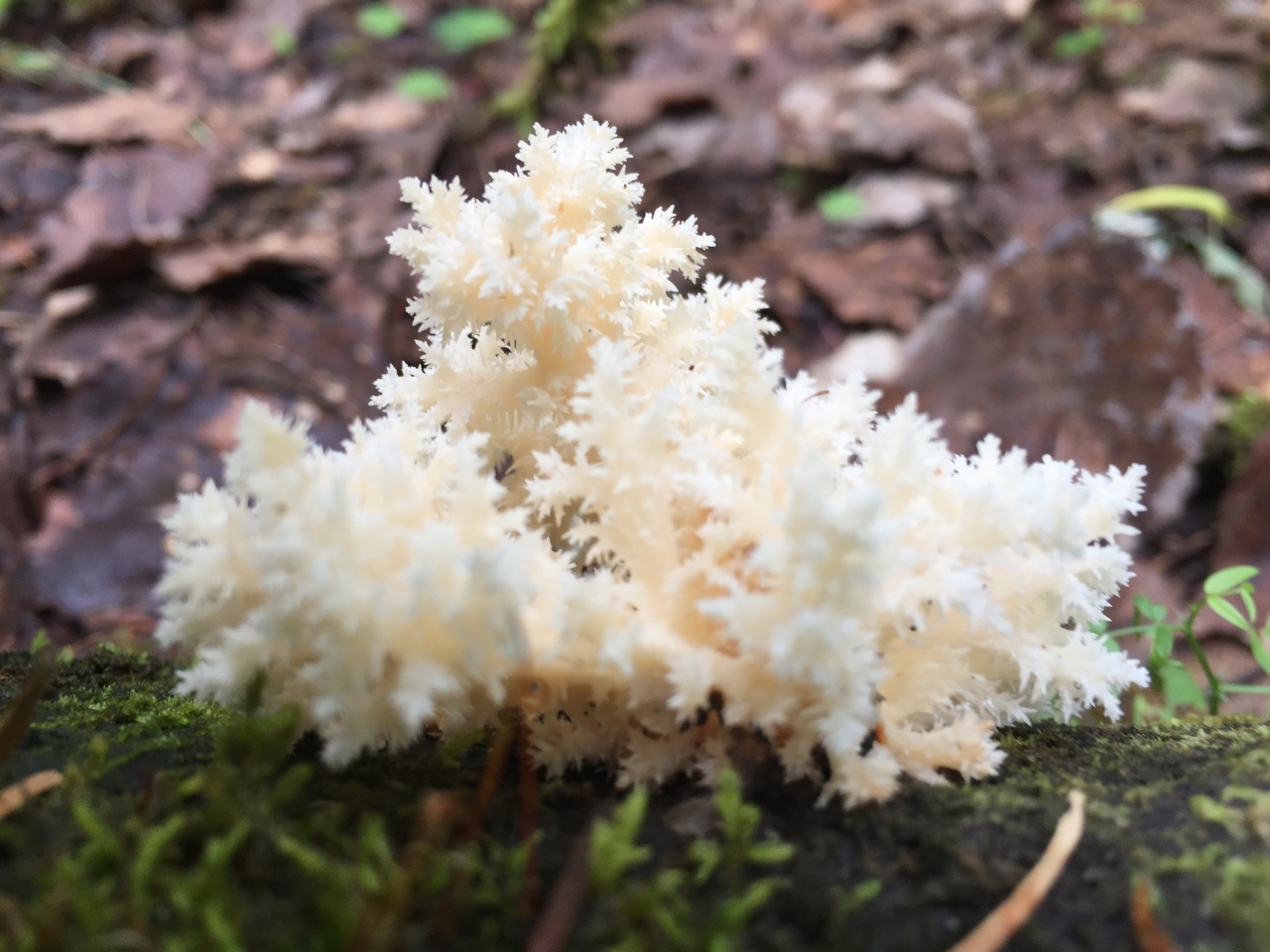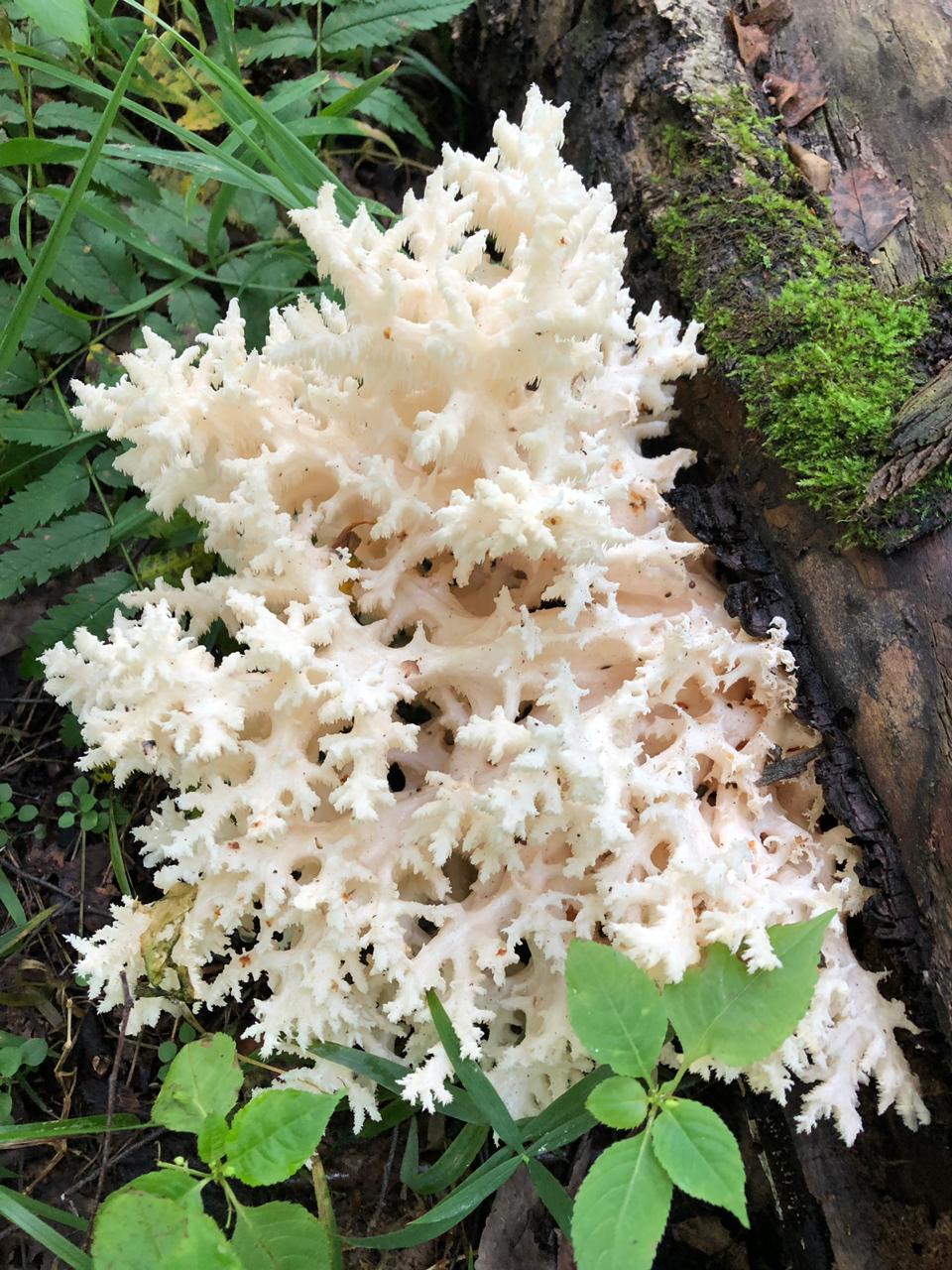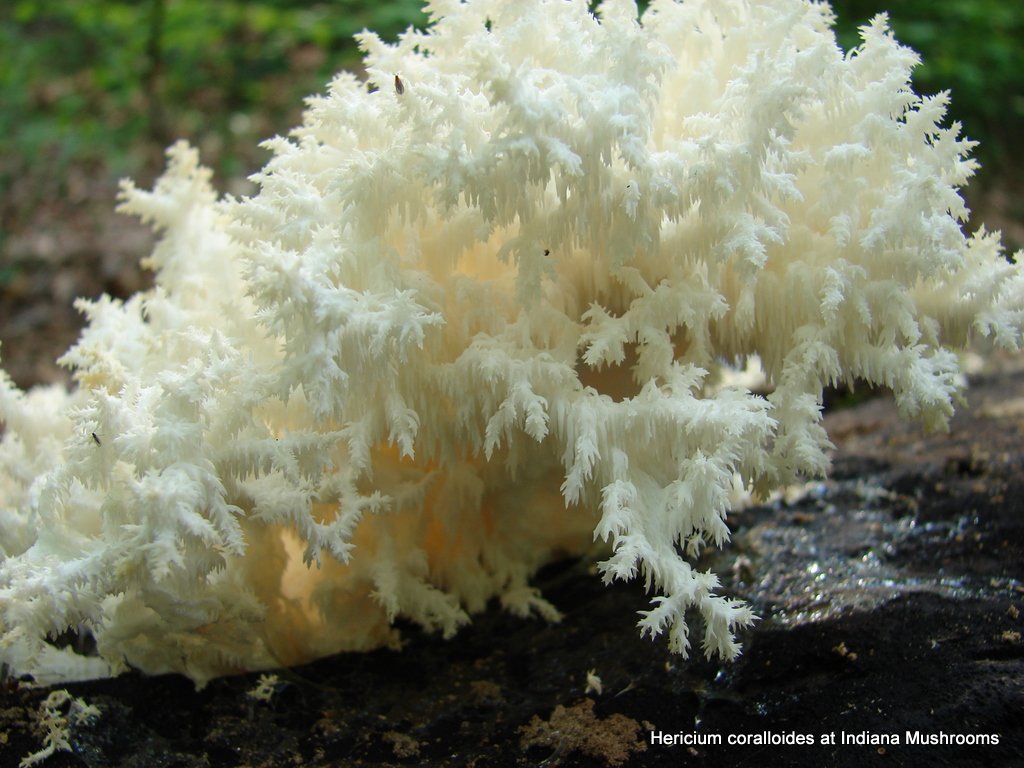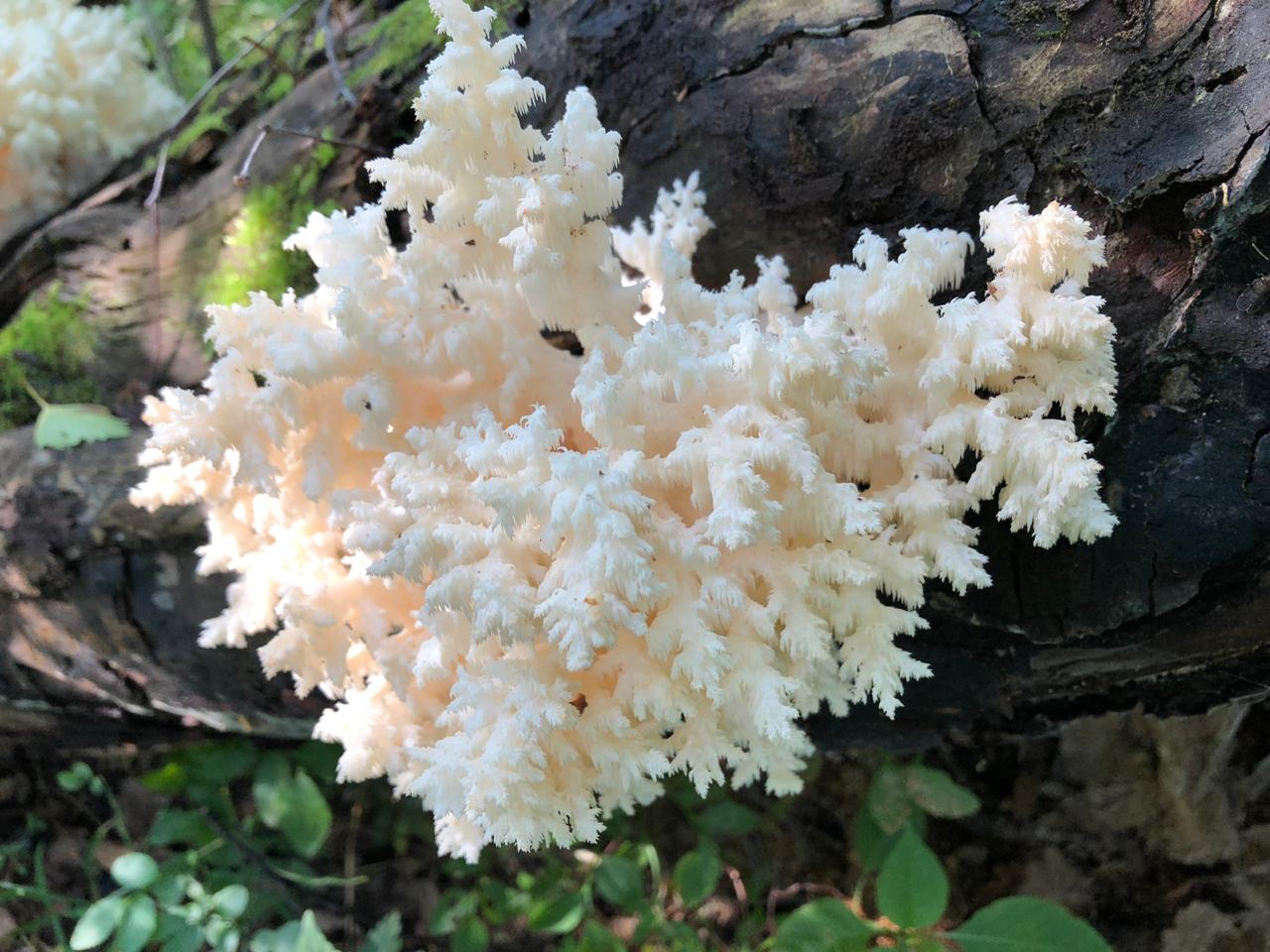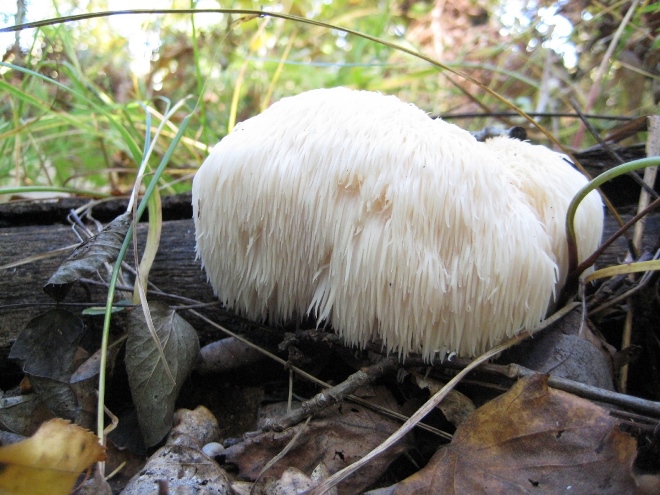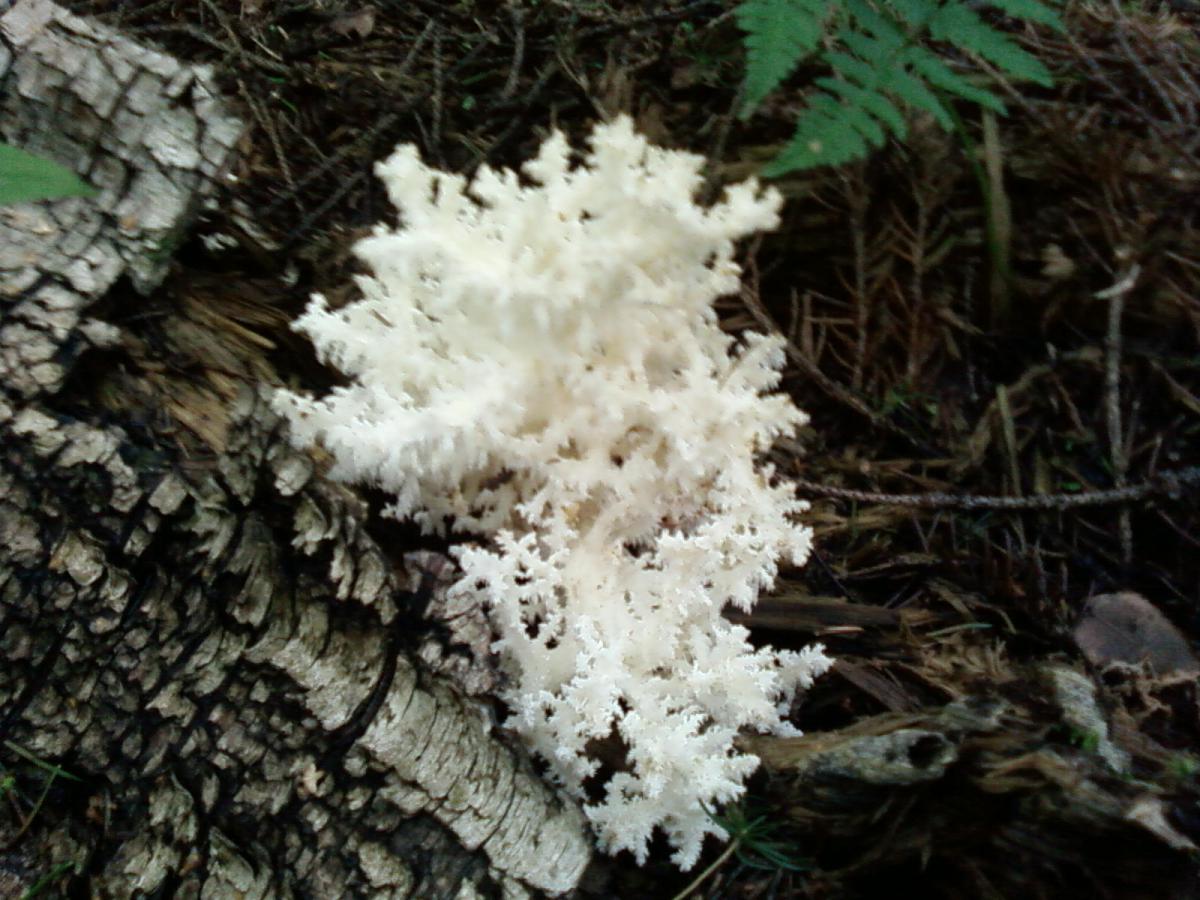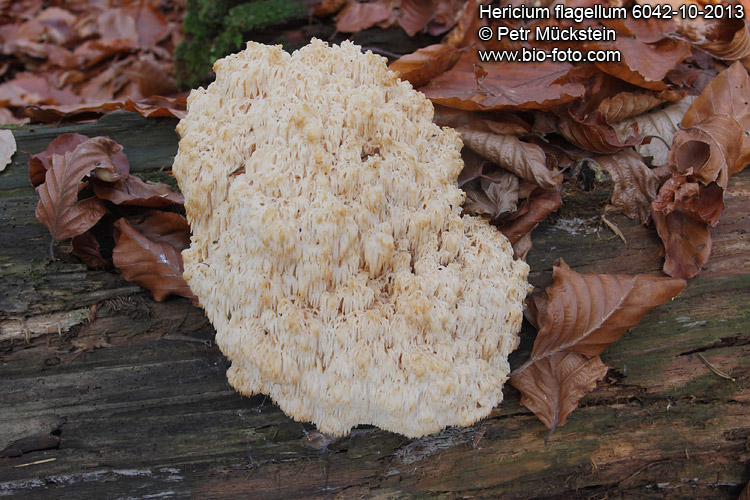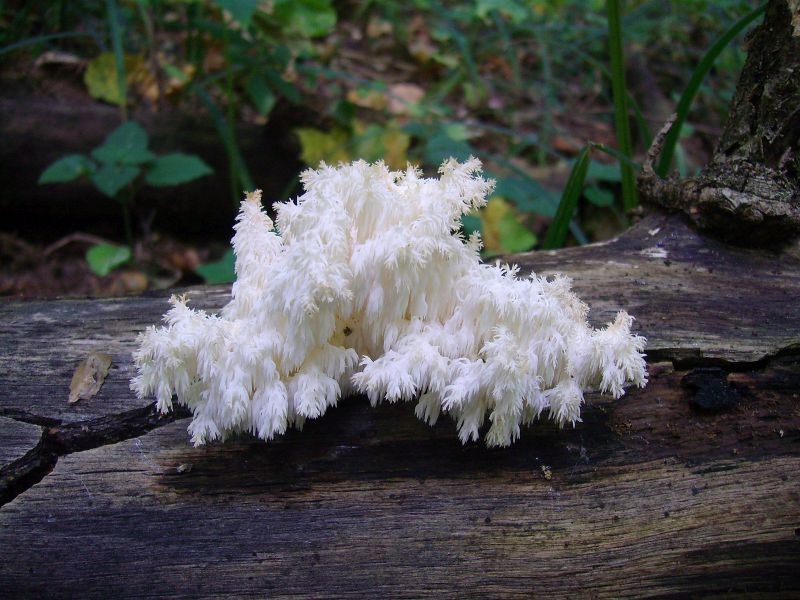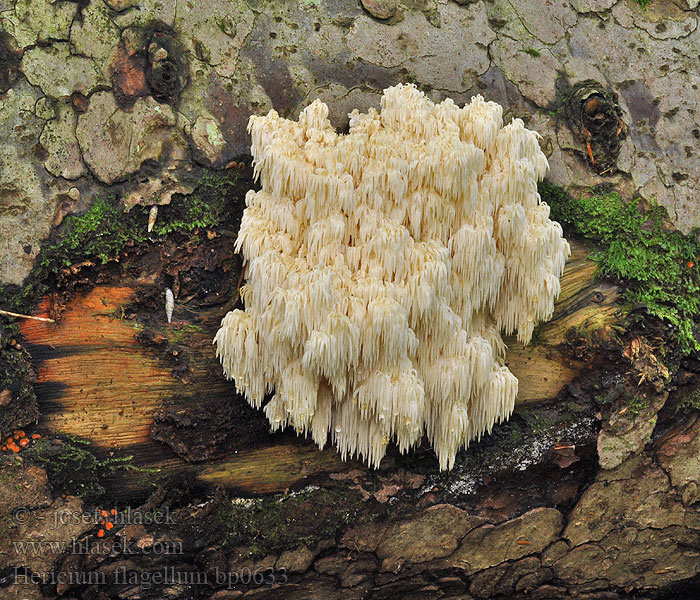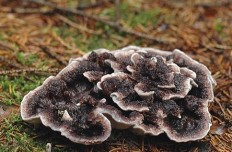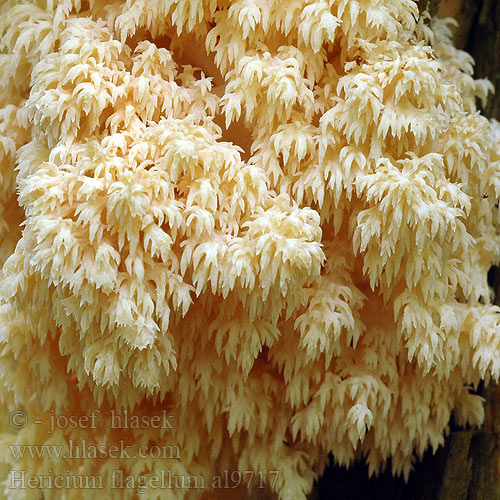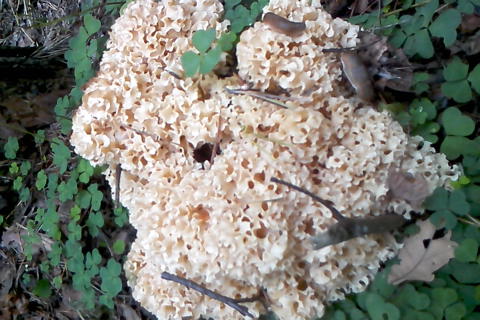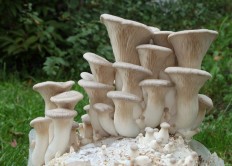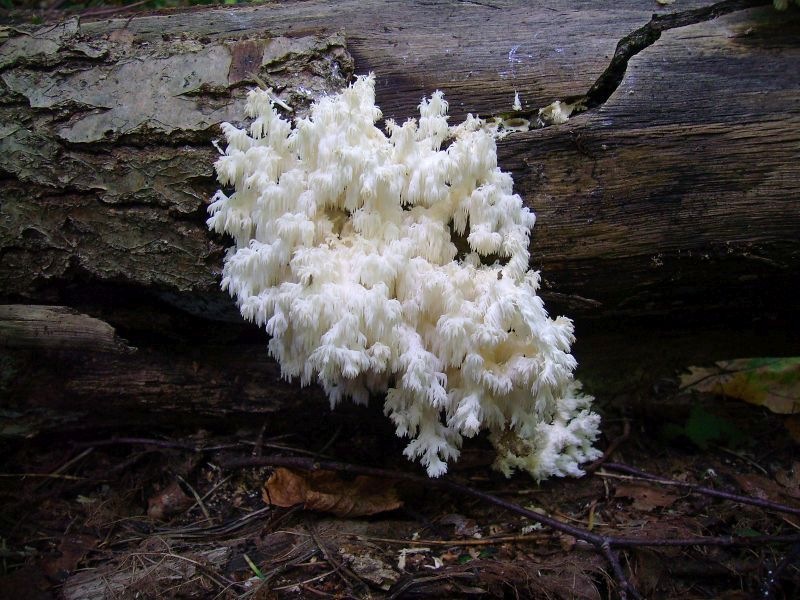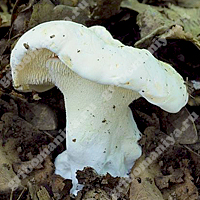White Hericium (Hydnum albidum)
Synonyms:
- Dentinum albidum
- Hydnum repandum var. albidum
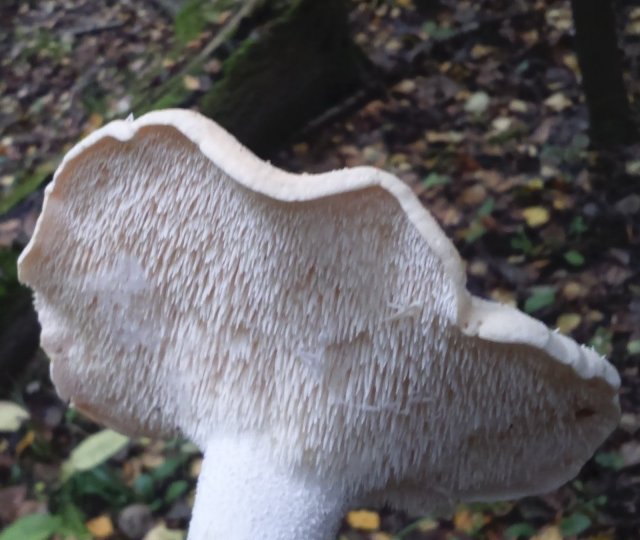
White Hericium (Hydnum albidum) differs little from the more well-known counterparts of the Yellow Hericium (Hydnum repandum) and Reddish-yellow Hericium (Hydnum rufescens). Some sources do not bother with separate descriptions for these three species, their similarity is so great. However, many sources note that the white hedgehog appeared (in Russia) relatively recently.
Description
Hat: White in various variations: pure white, whitish, whitish, with shades of yellowish and grayish. Blurry spots in the same tones may be present. The diameter of the cap is 5-12, sometimes up to 17 or even more, centimeters in diameter. In young mushrooms, the cap is slightly convex, with the edges bent down. With growth, it becomes prostrate, with a concave middle. Dry, firm, slightly velvety to the touch.
Hymenophore: Spines. Short, whitish, whitish-pinkish, conical, pointed at the ends, densely arranged, elastic in young mushrooms, become very brittle with age, easily crumble in adult mushrooms. Descend a little on the leg.
Leg: up to 6 cm high and up to 3 cm wide. White, dense, solid, does not form voids even in adult mushrooms.

Flesh: white, firm.
Smell: pleasant mushroom, sometimes with some "floral" tint. Taste: Information about the taste is rather contradictory. So, in the English-language sources it is noted that the taste of the white hedgehog is sharper than that of the yellow barn, even pungent, pungent. Russian-speaking people argue that these two species practically do not differ in taste, except that the flesh of the yellow is more tender. In overgrown specimens of white hedgehog, the flesh may become too dense, corky, and bitter. Most likely, these differences in taste are related to the place of growth (region, type of forest, soil).
Spore powder: White.
Spores are ellipsoidal, not amyloid.
Season and habitat
Summer - autumn, from July to October, however, these frames can shift quite a lot depending on the region.
It forms mycorrhiza with various deciduous and coniferous species of trees, therefore it grows well in forests of various types: coniferous (prefers pine), mixed and deciduous. Prefers moist places, moss cover. A prerequisite for the growth of white hedgehog is calcareous soil.
It occurs singly and in groups, under favorable conditions it can grow very heap, in large groups.
Distribution: North America, countries of Europe and Asia. It is massively distributed in countries such as Bulgaria, Spain, Italy, France. In Russia, it is seen in the southern regions, in the temperate forest zone.
Edibility
Edible. It is used boiled, fried, pickled. Good for drying.
According to some sources, it has medicinal properties.
Similar species
It is very difficult to confuse the white hedgehog with some other mushroom: the whitish color and "spines" are quite a bright business card.
The two closest species, the yellow hedgehog (Hydnum repandum) and the reddish-yellow hedgehog (Hydnum rufescens), differ in the color of the cap. Hypothetically, of course, a very light form of a yellow hair man (an adult, faded) can be very similar to a white one, but since an adult yellow bar is not bitter, it will not spoil the dish.
Other information about the mushroom
Hericium white, as a rather rare species, is listed in the Red Data Books of some countries (Norway) and some regions of Russia.
Description of alpine hedgehog
Fruit bodies are branched, tree-like, the base of fruit bodies sometimes grows strongly. The shape of Alpine hedgehogs can be different. The diameter of the mushroom reaches 15 centimeters, sometimes it can be larger. The height of the fruiting body ranges from 5 to 30 centimeters.The color of Alpine hedgehogs is pink; when dry, it becomes brownish or yellowish.

The hymenophore is thorny. Mature thorns can be more than 1 centimeter long. The thorns are straight or slightly curved. The color of the thorns matches the color of the fruiting body. These thorns are located at the ends of the branches and represent their final ramifications.
Spores are broadly ellipsoid, almost spherical, thick-walled with a large drop of oil.
Places of growth and number of alpine hedgehogs
Part of the range of Alpine hedgehogs is located on the territory of our country, they grow in Karelia, Krasnodar Territory, the Republic of Adygea, Primorsky Territory, Irkutsk Region, Khabarovsk Territory.
Outside of Russia, Alpine hedgehogs grow in Central, Southern and Western Europe, in addition, there are North American finds. These mushrooms grow in deciduous and mixed forests.

Alpine Hericium is a xylosaprotroph fungus that causes the development of corrosive rot. Alnepian black-haired hedgehogs settle on stumps, dry trees, dead wood, giving preference to cedar pine and fir. They are found in mountainous regions, and more rarely in taiga plain stumps. Alpine hedgehogs bear fruit from late summer to autumn.
Similarities with closely related species
The Alpine Hericium differs from the Coral Hericium in longer spines and a powerful base. In addition, the sizes of the disputes are also different for them.
Situation with numbers and security measures
In Russia, 15 localities of Alpine hedgehogs have been found, up to 500 specimens. These mushrooms do not bear fruit every year. Their fruiting bodies are solitary. There is no information on the state of local populations.
Alpine hedgehogs are included in the Red Book of the Republic of Adygea. Also, these mushrooms are protected in the Ussuriysky, Teberdinsky and Caucasian reserves. They also grow in protected areas of the northern Baikal region.

It is necessary to control the state of the population of Alpine hedgehogs. It is also necessary to search for new deposits.
How to cook black sheep's men
The French managed to appreciate the taste of the black men. In French cuisine, barnacles are a delicacy and are served as main courses, side dishes and appetizers. Also, all kinds of sauces and dressings for soups are prepared from these mushrooms. The advantage of the barnacles is that their fruiting bodies do not contain milky juice, which imparts bitterness.
Similar species
Caroloid Hericium can be confused with the Alpine Hericium. This is also an edible mushroom. Its fruit body is branched, bushy, 5 to 20 centimeters high with smooth, dense, long thorns. The color of the fruiting body is cream. The flesh of the coral coral is fibrous, elastic, white. She has a pleasant mushroom smell.
Coral-shaped black hairy mens grow from July to September. They are found in the deadwood of deciduous trees. Coral-like black hairy mens settle singly. This is a rare type of mushroom.

Hericium Erinaceus is also similar to Alpine Hericium. It is an edible mushroom. Its fruit body is irregular in shape, sessile, without a leg. It has long hanging spines, ranging in size from 2 to 5 centimeters. When poured, the spines become yellowish. The pulp is fleshy, white in color. These mushrooms grow in the Amur Region, Khabarovsk Territory, Primorsky Territory, Crimea, the Caucasus and China. Hericium Erinacea are extremely rare mushrooms listed in the Red Data Books of many countries. Hericium Erinaceus is an edible mushroom that tastes like shrimp meat.
Alpine Hericium (Hericium alpine, Alpine, Hericium flagellum): how it looks, where and how it grows, edible or not
| + |
|
CORAL BLACKBERRY (Hericium coralloides)
The fruit body of Gericia reaches 30 - 40 cm both in width and height and consists of numerous branches resembling coral, covered with soft thorns.
Coral Hericium loves to grow on fallen trunks and stumps of deciduous trees, prefers birch, linden, oak, aspen, less commonly found on elm and alder. The fungus actively destroys wood, which causes white rot.As a rule, it grows in rather gloomy dark places, where its white "corals" are striking from afar.
It grows from mid-summer to mid-September.
The pulp is white, the smell is weak, the taste is neutral (although the old specimens are bitter and knit).
It has no poisonous counterparts.
It is difficult to judge the taste of this hedgehog, very few people have tried it. For a long time it was believed that it was impossible to collect it because of its registration in the Red Book. Now the myth of the Red Book of the coral Hericium has been successfully dispelled. It's all about systematic confusion. At the time of the compilation of the red books, the name Hericium coralloides was understood as a slightly different species growing on coniferous wood, and indeed being a great rarity - Hericium alpestre. It is he, the Alpine Gericius, that is truly rare, and the coral-like one is a very commonplace species, which is confirmed by his numerous finds and the abundance of photos on the network. To eat or not to eat? The question is rather personal. Ancient manuscripts have survived to this day, in which Gericium is mentioned as food. On October 30, 1653, a decree was issued in Russia abolishing the death penalty for thieves and robbers. The death penalty was replaced by punishment. There is a written confirmation dating back to August 1654 that the robbers Vanka Krugly, Kirilko Krivoy and Vaska Vybeiglaz, caught near the village of Molvitino in the Kostroma province, were punished by eating gericium. For the sake of fairness, we note that no one had heard of corals at that time, and the black hairy man was called a damn wood sponge, which "grew overgrown in the forests." The robbers were forced to collect themselves, cook the stew and eat this brew. "From this meal, no one died either after a week, or after two ... or after eight, only they looked pitiful and they asked for bread, we couldn't, they said, there is more of that washcloth." And in the tenth week of this punishment, the robbers knelt before the villagers, repented of their sins, vowed never to break the law again and, as a sign of confirmation of their intentions, went to a monastery and led a righteous life there. The news of this story spread far beyond the limits of the Kostroma province and reached other robbers, they, frightened by such a fate, destroyed all the wood sponge, after which it almost disappeared from our forests.
So, it is quite obvious that irresponsible extermination of mushrooms can significantly reduce mushroom yields. And thanks to the ancient chronicles, we can trace how the folk idea of the Coral Ezovik has changed.
There are research results on the medicinal properties of Gericia. In Chinese medicine, Gericium is used in the treatment of gastrointestinal diseases, and is also useful for enhancing immunity, the functioning of the respiratory system, regulating nervous diseases, and stimulating hematopoiesis. And a special Chinese tincture from Gericia is still used to bring a person out of depression.
Coral Hericium does not grow in vain on fallen trees
When you are lucky enough to meet this beautiful mushroom, do not rush to pass by, sit on a log, admire the beauty of the gericium, see its complex anatomy, gently touch its "twigs" and feel the joy of contact with Nature. And if you feel that this is "your mushroom", take it and fry
Description of coral hedgehog
Outwardly, this mushroom resembles a spreading coral. The color of the mushroom is pale yellow, milky, whitish or beige. The fruit body is bushy with dense spinous processes. The length of the mushroom reaches 30 centimeters, and the width ranges from 5 to 40 centimeters.
The branches are straight, their diameter is about 0.5 centimeters. Inside, the branches are hollow, they end with sharp tips, and are completely covered with small thorns. As the fungus grows, the thorns also lengthen, reaching 0.5-1 centimeters. The thorns hang down from the branches.
The base of the coral urchin is short, its diameter is about 1 centimeter, almost scaly.The pulp is white, slightly pinkish, fibrous, fleshy. When dry, the softness becomes ocher. The pulp has a bright mushroom smell and a pleasant taste. But only young specimens are suitable for food.
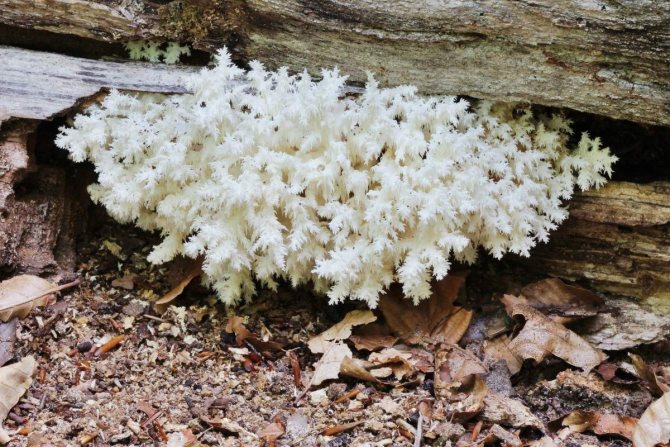
Spores are elliptical in shape, can be spherical, with rough, slightly thickened walls.
Distribution of coral barnacles
Perennial coral barnacle mycelium. Young mushrooms scatter branches to the sides, and in older specimens they hang down.
These mushrooms settle on stumps and deadwoods of mixed, coniferous and deciduous species. Coral Hericiums can be found on aspen, linden, birch, elm, alder and oak.

Hedgehogs parasitize trees, causing white rot in them. You can spot these mushrooms in the forest from July to October. Most often they are found as separate specimens.
The number of coral-like hedgehogs
The coral herd flies cannot be collected, since their number is small, and they are listed in the Red Book, where they are noted as a rare species.
These mushrooms grow in Europe, Siberia, the Urals, the Far East, the Caucasus and Krasnodar Territory.
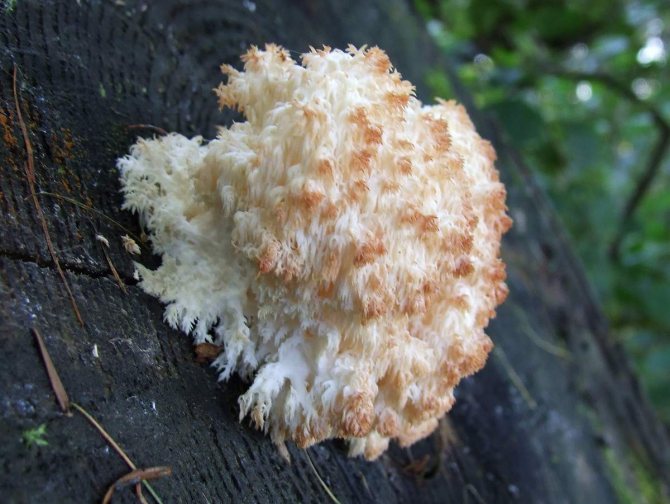
Doubles and their differences
It is rather difficult to confuse the coral hericium with other mushrooms - according to the description of the coral hedgehog, it is clear that it looks very unusual. It looks much more like a bizarre plant or coral than a mushroom. However, in the absence of experience, he can be mistaken for related hedgehogs, also distinguished by a non-standard appearance.
Crested hedgehog
This related species, which grows on tree trunks, may look a little like a coral hedgehog in adulthood, since a long, frequent fringe of a light beige or whitish color hangs from its cap very abundantly. Thanks to this, the mushroom is also called "airy fish". Sometimes the fringe of the mushroom can be slightly raised above the surface of the cap, in which case it becomes especially similar to the coral hedgehog.

However, it is easy to distinguish mushrooms - the coral species has a more bushy and uneven structure. The long fringe of the crested blackberry is usually directed downward, the needles themselves are even and straight, in contrast to the curved spines of the coral mushroom.
Important! Like the coral, the crested hedgehog is suitable for human consumption. However, it is not recommended to collect it, since the mushroom is very rare and is listed in the Red Book.
Hericium's antennae
Another similar species is the barbel hedgehog, which grows on tree trunks, usually arranged in a tiled arrangement, with several caps next to each other. The tips of the barbel urchin are white or slightly pinkish, turning yellow with age, covered from above with densely appressed spines. From the underside of the caps hang dense long spines with sharp tips, whitish in young mushrooms and yellowing in old ones.

It is possible to distinguish the barbel hedgehog from the coral one by the shape - the spines of the fungus are directed downward from the hymenophore, while in the coral hericium they grow in all directions in a bushy order. Like the coral hericium, the barbel hedgehog is edible at a young age, as long as its flesh remains tender enough.
Types of these mushrooms, appearance
Hericium (blackberry, barnyard) is a common name for mushrooms from different families, which got their name because of their unusual appearance. Previously, almost all of them belonged to the genus Hydnum, but the subsequent classification changed this affiliation. Blackberry mushrooms (photo and description are given in the review) look different, there are quite a large number of them.

- Hericium white belongs to the genus Hydnum of the family Yezhovikovs. The mushroom has a white cap of different shades, the diameter of which reaches 10-15 cm. The surface of the cap is dry and plush to the touch. The leg is never empty. The hymenophore consists of a large number of outgrowths similar to the spines of a hedgehog. Spines grow very densely, in adult specimens they easily break, crumble.
- Hericium coral (branched, trellate) visually resembles white or cream-colored sea coral. This unique, extremely rare (edible) species from the genus Gericia (Gericiaceae) is unlike any other mushroom. It grows as a dense bush of fragile thorns on fallen branches and stumps of deciduous trees during the summer, at the beginning of autumn.
- Antennal creolophus belongs to arboreal saprotrophs, grows in the form of hemispherical fruit bodies of white, light cream color, belongs to the genus Gericium. It reaches 15 cm in height and 20 cm in length. The body of the mushroom is fleshy, most often it grows in layers of fan-shaped form one above the other. The surface is covered with white, yellowish spines of various lengths (can reach 1 cm). This edible mushroom can grow up to 1 kg in weight.
- Hericum tiled (variegated) belongs to the genus Sarkodon, the Banker family. This fleshy mushroom sometimes grows up to 20 cm in diameter. The brown cap has a flat or funnel-shaped shape, its entire surface is decorated with circles (concentric) of convex scales sticking up or at an angle. A needle hymenophore is located under the cap. The leg is widened under the cap, becomes hollow with age. The mushroom is edible.
- The lion's mane (combed hedgehog), genus Herzievs, is called by the common people mushroom noodles, grandfather's beard, in Japan it is called yamabushitake, in China - houtougu (monkey head). An exotic, rare mushroom that grows up to 2 kg in weight. It happens white, sandy, pinkish. It is prized as a delicacy (it tastes like shrimp meat).
There are other types of black hairs: reddish-yellow, black, rough, yellow barnacles, devilish, alpine, and others. Not all of the species are edible.


